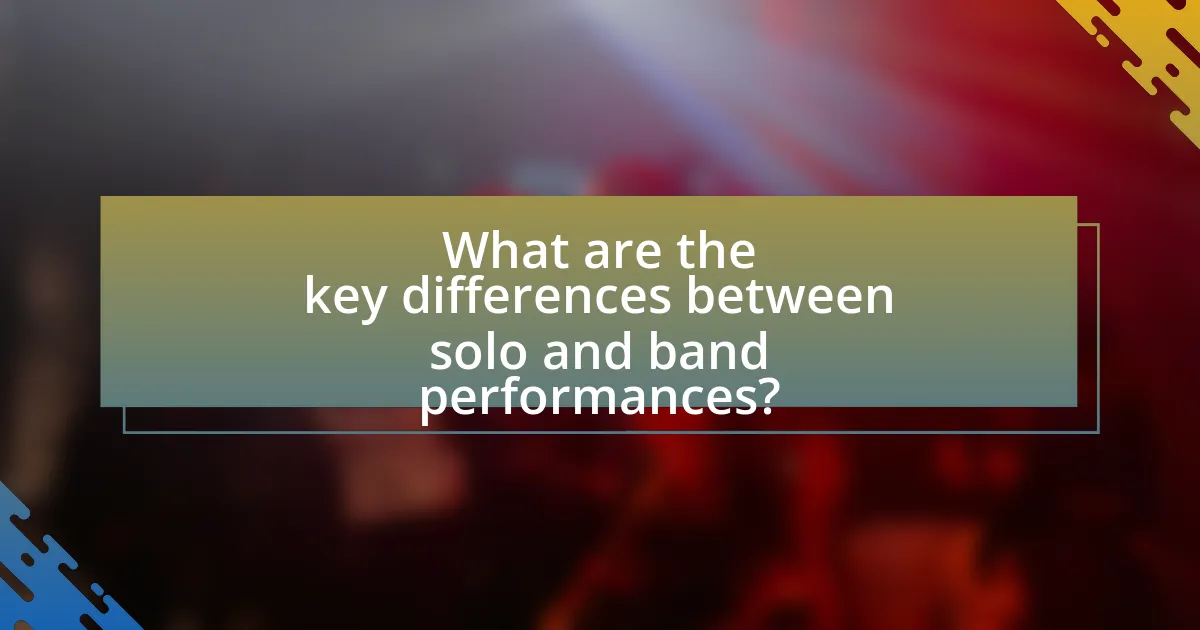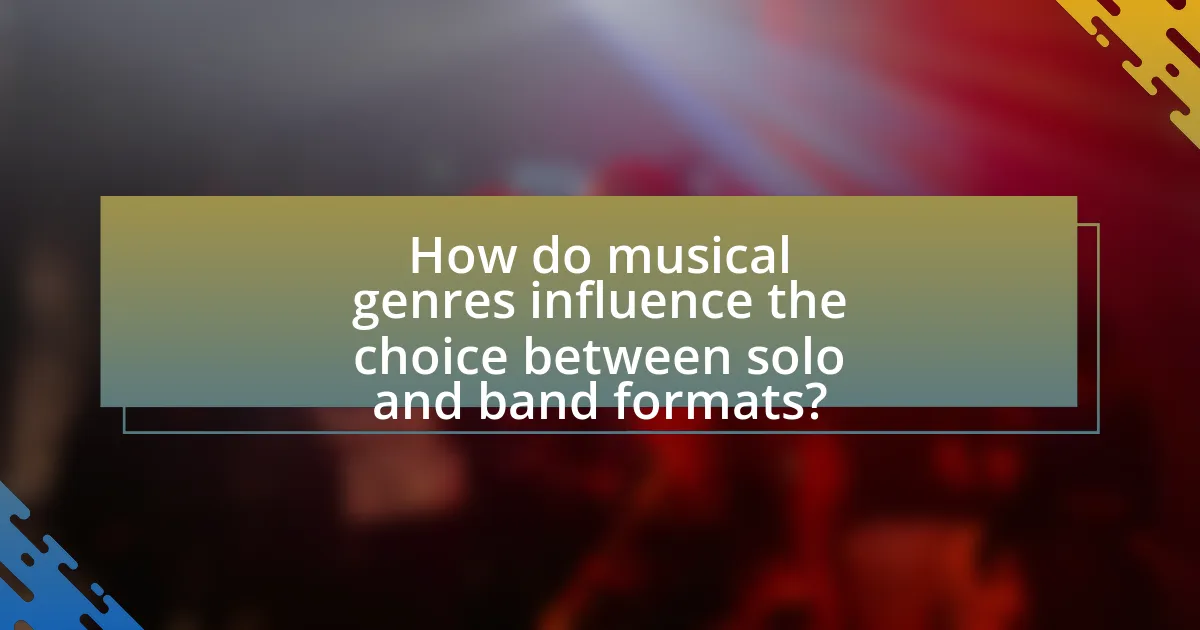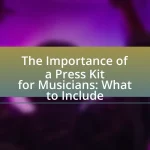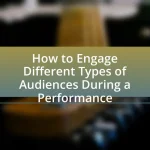The article examines the key differences between solo and band performances, highlighting aspects such as creative control, audience engagement, and the dynamics of collaboration. It discusses how solo artists connect with their audience through storytelling and emotional authenticity, while bands create a dynamic experience through collective sound and visual elements. The article also addresses the advantages and disadvantages of each format, including logistical challenges, financial implications, and the influence of musical genres on performance choices. Additionally, it outlines best practices for both solo artists and bands to enhance their performances and promote their work effectively.

What are the key differences between solo and band performances?
Solo performances involve a single artist showcasing their talent, while band performances consist of multiple musicians collaborating to create a collective sound. In solo performances, the artist has complete creative control over the music, presentation, and interpretation, allowing for a personal connection with the audience. Conversely, band performances require coordination and collaboration among members, leading to a diverse range of sounds and styles, but also necessitating compromise on artistic decisions. Additionally, solo performances often focus on individual expression, while band performances emphasize teamwork and synergy, resulting in a richer, more layered musical experience.
How does the performance format impact audience engagement?
The performance format significantly impacts audience engagement by influencing the emotional connection and interaction level between performers and the audience. Solo performances often create an intimate atmosphere, allowing for direct communication and personal storytelling, which can enhance emotional resonance. In contrast, band performances typically generate a more dynamic and energetic environment, encouraging collective participation through rhythm and shared experiences. Research indicates that audiences are more likely to engage actively, such as dancing or singing along, during band performances due to the collaborative energy and visual stimulation provided by multiple performers. This distinction in engagement levels is supported by studies showing that audience satisfaction and involvement are higher in formats that foster interaction, such as group performances, compared to solo acts.
What techniques do solo artists use to connect with their audience?
Solo artists use techniques such as storytelling, audience interaction, and emotional authenticity to connect with their audience. Storytelling allows solo artists to share personal experiences and narratives, creating a relatable atmosphere that resonates with listeners. Audience interaction, such as asking questions or inviting participation, fosters a sense of community and engagement during performances. Emotional authenticity, demonstrated through genuine expression and vulnerability in their music, helps solo artists forge deeper connections with their audience. These techniques are effective as they enhance the overall experience, making performances memorable and impactful.
How do bands create a dynamic experience for their audience?
Bands create a dynamic experience for their audience by engaging multiple senses through a combination of live music, visual elements, and audience interaction. The use of varied musical arrangements, energetic performances, and synchronized lighting enhances the overall atmosphere, making the experience more immersive. For instance, studies show that live music performances can increase emotional responses in audiences, leading to a stronger connection with the band. Additionally, bands often incorporate crowd participation, such as sing-alongs or call-and-response segments, which fosters a sense of community and involvement among attendees. This multifaceted approach not only entertains but also creates memorable experiences that resonate with the audience long after the performance.
What are the advantages and disadvantages of solo performances?
Solo performances offer the advantage of complete artistic control, allowing the performer to express their vision without compromise. This autonomy can lead to a more personal and intimate connection with the audience, as seen in solo concerts where the artist’s individual style and interpretation shine through. However, the disadvantages include the potential for increased pressure on the performer, as they bear the full responsibility for the success of the performance. Additionally, solo performances may lack the dynamic interplay and energy that can be generated in group settings, which can affect audience engagement.
How does a solo artist manage all aspects of a performance?
A solo artist manages all aspects of a performance by taking on multiple roles, including performer, promoter, and technician. This individual is responsible for selecting the setlist, arranging the music, and rehearsing extensively to ensure a polished presentation. Additionally, the solo artist handles logistics such as booking venues, marketing the performance, and managing sound equipment.
For instance, a solo musician may use digital audio workstations to create backing tracks, allowing them to perform with a fuller sound while still being the sole performer on stage. This approach enables them to maintain creative control and adapt their performance to different venues and audiences. The necessity for self-sufficiency in these areas is supported by the fact that many successful solo artists, like Ed Sheeran, utilize technology to enhance their live shows, demonstrating the effectiveness of this management style.
What challenges do solo performers face compared to bands?
Solo performers face several challenges compared to bands, primarily in terms of resource limitations, audience engagement, and performance dynamics. Solo artists often lack the collaborative support that bands provide, which can lead to increased pressure on the individual to manage all aspects of performance, including songwriting, instrumentation, and promotion. This can result in a heavier workload and potential burnout.
Additionally, solo performers may struggle with audience engagement, as bands can create a more dynamic and interactive experience through multiple members contributing to the performance. Research indicates that audiences often respond more positively to group performances due to the variety and energy that multiple performers bring, making it harder for solo acts to capture and maintain attention.
Moreover, solo performers typically have fewer financial resources for marketing and touring compared to bands, which can limit their exposure and opportunities for growth in the music industry. These challenges highlight the distinct hurdles solo artists must navigate in contrast to their band counterparts.
What are the advantages and disadvantages of band performances?
Band performances offer several advantages and disadvantages. The primary advantage is the ability to create a richer, more dynamic sound through collaboration among multiple musicians, which enhances the overall musical experience for the audience. Additionally, bands can engage in complex arrangements and harmonies that are often not achievable in solo performances. A study by the University of Southern California found that live band performances can increase audience engagement by up to 30% compared to solo acts.
On the downside, band performances can face challenges such as coordination issues, where differing schedules and personalities may lead to conflicts. Furthermore, the financial burden of maintaining a band, including equipment and venue costs, can be significant. According to a survey by the Music Industry Research Association, 40% of bands reported financial difficulties as a major concern, impacting their ability to perform consistently.
How do band dynamics influence the overall performance?
Band dynamics significantly influence overall performance by affecting communication, cohesion, and energy levels among members. Effective communication within a band fosters collaboration, allowing musicians to respond to each other’s cues and adapt during live performances. Cohesion among band members enhances the synergy of their sound, creating a more engaging experience for the audience. Additionally, positive interpersonal relationships can elevate the energy levels on stage, leading to a more dynamic and captivating performance. Research indicates that bands with strong interpersonal dynamics often receive higher audience ratings and engagement, demonstrating the critical role of these dynamics in live music settings.
What are the logistical challenges of performing as a band?
The logistical challenges of performing as a band include coordinating schedules, managing equipment transport, and ensuring adequate sound setup. Bands often consist of multiple members, which complicates scheduling rehearsals and performances due to varying personal commitments. Additionally, transporting instruments and sound equipment requires careful planning to avoid damage and ensure everything arrives on time. Proper sound setup is crucial for live performances, necessitating collaboration with sound engineers and venue staff to achieve optimal audio quality. These challenges highlight the complexity of band logistics compared to solo performances, where fewer variables are involved.

How do musical genres influence the choice between solo and band formats?
Musical genres significantly influence the choice between solo and band formats due to their inherent characteristics and audience expectations. For instance, genres like classical and jazz often favor solo performances, allowing for individual expression and technical showcase, as seen in solo violin or piano recitals. In contrast, rock and pop genres typically thrive in band formats, where collaboration among musicians enhances the overall sound and energy, exemplified by iconic bands like The Beatles and Queen. This preference is supported by audience engagement patterns, where live performances in band formats often attract larger crowds, reflecting the collaborative nature of these genres.
What genres are typically associated with solo performances?
Genres typically associated with solo performances include classical, folk, jazz, and singer-songwriter music. Classical music often features solo instrumentalists or vocalists, showcasing individual talent and interpretation. Folk music allows for personal storytelling through solo performances, while jazz often highlights improvisation by solo musicians. Singer-songwriters present their original compositions, emphasizing personal expression and connection with the audience. These genres are characterized by their ability to convey emotion and artistry through individual performance.
How do solo performances enhance the storytelling aspect in certain genres?
Solo performances enhance the storytelling aspect in certain genres by allowing a single artist to convey a focused narrative through their unique interpretation and emotional expression. This singular perspective enables deeper audience connection, as the performer can infuse personal experiences and emotions into the story, creating a more intimate atmosphere. For example, in genres like folk music or spoken word poetry, the solo artist often uses their voice, body language, and minimalistic instrumentation to emphasize key themes and emotions, making the storytelling more impactful. Research indicates that audiences often perceive solo performances as more authentic, as they can witness the artist’s vulnerability and creativity firsthand, which reinforces the narrative’s emotional weight.
What genres are typically associated with band performances?
Band performances are typically associated with genres such as rock, jazz, pop, and country. These genres often feature multiple instrumentalists and vocalists, creating a dynamic sound that is characteristic of band settings. For instance, rock bands commonly include electric guitars, bass, drums, and vocals, while jazz ensembles may incorporate brass and woodwind instruments alongside rhythm sections. The prevalence of these genres in live performances is supported by data from concert attendance statistics, which show that rock and pop concerts consistently attract large audiences, highlighting their popularity in band formats.
How do bands collaborate to create a cohesive sound in specific genres?
Bands collaborate to create a cohesive sound in specific genres by integrating their individual musical styles, skills, and influences into a unified artistic vision. This process often involves regular communication, shared songwriting responsibilities, and collective decision-making regarding arrangements and instrumentation. For instance, in rock music, band members may blend distinct guitar riffs, drum patterns, and vocal harmonies to achieve a signature sound that resonates with the genre’s characteristics. Research indicates that successful collaboration enhances creativity and leads to a more polished final product, as seen in bands like The Beatles, who famously combined diverse influences to innovate within pop and rock music.

What factors should artists consider when choosing between solo and band formats?
Artists should consider creative control, financial implications, and audience engagement when choosing between solo and band formats. Creative control is often greater in a solo format, allowing artists to express their vision without compromise. Financial implications include the division of earnings; solo artists retain all profits, while bands must share income, which can affect overall revenue. Audience engagement varies, as solo performances can create an intimate atmosphere, while bands may offer a more dynamic and energetic experience. These factors are crucial for artists to align their performance format with their artistic goals and business strategy.
How does personal style influence the choice of performance format?
Personal style significantly influences the choice of performance format by dictating the artist’s preferred method of expression and connection with the audience. For instance, an artist with a strong inclination towards intimate storytelling may opt for a solo performance to create a personal atmosphere, while a performer who thrives on collaboration and energy might choose a band format to enhance the overall experience. Research indicates that artists often select performance formats that align with their artistic identity and emotional expression, as seen in studies highlighting the correlation between personal style and audience engagement levels.
What role does the artist’s experience play in this decision?
The artist’s experience significantly influences the decision between performing solo or with a band. Experienced artists often possess a deeper understanding of their musical style, audience engagement, and performance dynamics, which can lead them to prefer one format over the other. For instance, an artist with extensive live performance experience may choose to perform solo to showcase their individual artistry and connect more intimately with the audience. Conversely, an artist who has collaborated with a band may opt for that format to leverage the collective energy and diverse sound that a group can provide. This choice is supported by research indicating that artists with varied performance backgrounds tend to make more informed decisions about their presentation style, enhancing their overall effectiveness and audience reception.
What logistical considerations are involved in choosing a performance format?
Choosing a performance format involves several logistical considerations, including venue size, equipment requirements, and audience engagement strategies. Venue size dictates the number of performers and the type of setup needed; for instance, a solo act may require less space and equipment compared to a full band, which needs more instruments and sound systems. Equipment requirements also vary significantly; a solo performer might only need a microphone and a guitar, while a band requires multiple microphones, amplifiers, and possibly a sound engineer. Additionally, audience engagement strategies differ; solo performances often rely on personal connection, while bands may focus on group dynamics and visual spectacle. These factors collectively influence the decision-making process in selecting an appropriate performance format.
How do budget constraints affect the decision between solo and band performances?
Budget constraints significantly influence the decision between solo and band performances by limiting the financial resources available for hiring multiple musicians. When budgets are tight, artists often opt for solo performances, which require fewer expenses related to additional band members, such as salaries, travel, and equipment costs. For instance, a solo artist can perform with minimal setup and lower overhead, making it a more financially viable option in constrained circumstances. Conversely, band performances typically involve higher costs due to the need for multiple performers, which can deter artists from pursuing this format when funds are limited.
What are some best practices for artists performing solo or with a band?
Artists performing solo or with a band should prioritize preparation, audience engagement, and sound quality. Preparation involves rehearsing thoroughly to ensure a polished performance, which is crucial for both solo artists and bands. Engaging the audience through eye contact, storytelling, and interactive elements enhances the overall experience, making the performance memorable. Additionally, ensuring high sound quality through proper equipment setup and sound checks is essential, as poor audio can detract from the performance. These practices are supported by industry standards, which emphasize the importance of professionalism and audience connection in live performances.
How can solo artists effectively promote their performances?
Solo artists can effectively promote their performances by leveraging social media platforms, engaging with local communities, and utilizing email marketing. Social media allows artists to reach a broad audience, share performance details, and interact with fans, which is crucial for building a following. For instance, platforms like Instagram and Facebook have proven effective for artists to showcase their work and announce events, with 54% of musicians reporting increased engagement through these channels. Engaging with local communities through collaborations with local businesses or participating in community events can also enhance visibility and attract local audiences. Additionally, email marketing enables solo artists to directly communicate with their fan base, providing updates on performances and exclusive content, which can lead to higher attendance rates.
What strategies can bands use to enhance their live shows?
Bands can enhance their live shows by incorporating dynamic stage presence, engaging visuals, and audience interaction. Dynamic stage presence involves musicians moving around the stage, making eye contact, and expressing energy, which can significantly elevate the audience’s experience. Engaging visuals, such as coordinated lighting, backdrops, and video projections, create an immersive atmosphere that captivates attendees. Audience interaction, including call-and-response segments or inviting fans on stage, fosters a sense of connection and participation, making the performance memorable. These strategies are supported by research indicating that live performances with high energy and audience engagement lead to increased audience satisfaction and retention.















